Yes, you can still go hiking with your baby when the weather gets cold or even starts snowing. However, I’d be lying if I didn’t admit that it’s a lot harder. If you don’t plan for it and dress properly, it can be a miserable or even dangerous experience. Here’s how to have a good winter hike with your baby.
Limit Hikes to a Max of 2 Hours
As one of my mom friends pointed out, your baby hasn’t figured out how to do things like blow into his hands to warm up his face. So, while you might not be cold, your baby can get uncomfortable quickly.
To prevent frostbite and grumpiness, try to limit hikes to a max of 2 hours when it is below freezing temperatures. This is enough time to enjoy nature without risking hypothermia. If things go well, you can gradually increase your time outdoors.
Remember that it takes a lot longer to hike when it is snowy or slippery ground. Use this method to calculate how long it will take to complete a hike.
What to Pack
Whenever you go hiking, you should always prepare for the worst. No matter how experienced of a hiker you are, you can still get injured or lost. Pack survival gear in case you end up spending the night!
That means carrying gear like extra water, a firestarter, a mini first aid kit, and headlamp (see the hiking packing list here).
When hiking with babies or toddles in winter though, you’ll need some specific extra gear. Pack:
Insulated Foam Pad
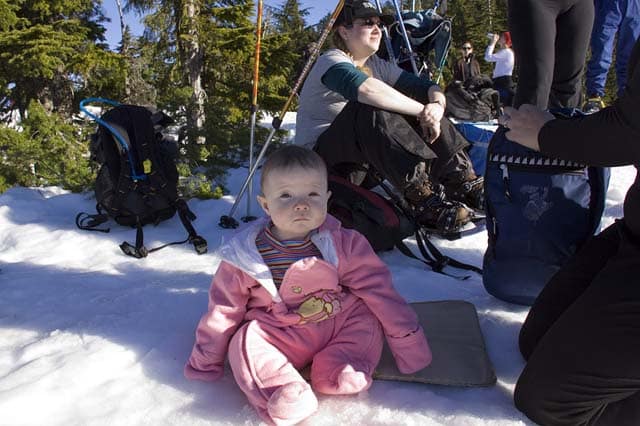
Baby sitting on an insulated pad to stay warm during a rest at the summit.
There are two reasons to bring one of these. First, it serves as a diaper changing pad. You don’t want to put your baby down on the cold or snowy ground to change a diaper!
Secondly, the pads are great for when you want to take a break from carrying your baby. You can put her down on the pad to sit and play a bit while you rest.
Make sure the pad has an R-value of at least 2.5. This level of insulation will keep the cold ground from sucking the heat out of her body. The Therm-a-Rest Z-Lite SOL is a good option (R-value 2.6). It’s affordable, easy to pack, and comes in various sizes.
Extra Clothes for Your Baby
If your baby gets wet while hiking in cold weather (diaper explosions, milk leaking down neck…), it can be very dangerous. Wetness causes heat loss from evaporative cooling. That can quickly lead to hypothermia, even if it isn’t that cold out.
It really isn’t practical to carry an extra outer layer for your baby. However, you absolutely should carry an extra base and mid layer. Also carry extra socks and booties.
Hot Water in an Insulated Bottle
Having a hot drink will do wonders for warming you and your baby up in cold weather. You’ll probably need two bottles: one with drinks for you and another with hot water for your baby (can also be used for mixing formula).
When it is below zero, do not use a metal bottle! It will freeze shut, or your lips will get stuck to it! Instead, check out these winter water bottles and insulators.
Trekking Poles
I always use trekking poles when hiking with my body. I’ve got weak knee joints and the poles make me much more stable when going down hills with a heavy baby on my back. There are numerous other benefits to using trekking poles too.
When hiking with a baby in cold weather, it’s even more important to use poles. The ground can be very hard and slippery. If it’s icy out, then absolutely put tips on your poles for ice!
Snot Rags
In cold weather, your baby’s nose will probably start running. Tie a rag around your pack or carrier that can be used for wiping away snot. Otherwise your baby will get really gross. A rag beats having to use a zillion tissues.
*Tip: Put a bit of Vaseline under your baby’s nose before heading out. This will prevent her nose from getting red from repeated wiping.
Changing Diapers in Cold Weather
You should always change your baby’s diaper in the car before you head out on your hike. If the diaper just gets wet with pee, I won’t change it until we get back. But poo absolutely has to be changed. If I wait too long, the poo can explode out of the diaper and then I really have a problem!
Remember how I said to bring an insulated pad? This will make your life much easier when doing diaper changes outdoors in the cold. Avoid putting your baby on the cold ground at all costs. If you didn’t bring an insulated pad, you could try doing the change on the carrier or even your jacket.
There’s not too much you can do to keep your baby’s butt warm while changing the diaper. Just:
- Get all the diaper supplies ready before you undress your baby
- Change as quickly as possible
- Try to choose a spot away from wind
- Think about diaper changes when choosing how to dress your baby
Dressing Your Baby for Cold-Weather Hiking
Obviously, you want to dress your baby in layers of clothing. Preferably, you choose materials made out of Merino wool. This is by far the warmest option while still being breathable. If you can’t afford Merino (who wants to pay a fortune for baby long johns only to outgrow them in a month?), then fleece is a good alternative.
You can also get away with synthetic materials when hiking in cold weather. But never dress your baby in cotton! It absorbs sweat and will not dry, so your baby risks ending up very wet and cold.
Basic Layers for Babies and Toddlers
Layer 1: Base
The main purpose of this layer is to wick moisture away from the body. So, it must be a material like wool or synthetic.
The base layer should fit snugly and cover all skin on the torso, arms and legs. I prefer two-piece base layers (long johns and a shirt) instead of a onesie because it makes diaper changes easier.
Merino wool jammies make a great base layer and can also be used everyday for sleeping in.
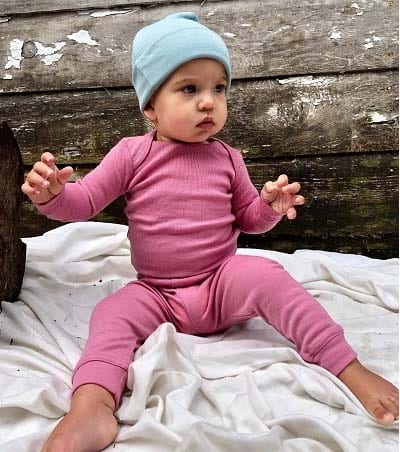
Simply Merino wool pajama set, available here
Layer 2: Mid
The purpose of the mid layer is to trap heat against the body. The mid layer should not be too tight or it won’t have enough air space to trap heat. Fleece or wool pants and a sweater work great for this layer. If it’s really cold, add a vest or extra mid layer.
Layer 3: Outer Shell
This is the layer that gets exposed to the elements. It should be water-resistant and windproof. I prefer a one-piece snow suit because you can unzip it to do diaper changes. You can use bib-snow pants and a jacket, but the pants have to be completely removed when changing diapers.
Your baby will also need a warm hat. Their necks can get really cold too, so it’s recommended to use a buff or scarf.
Keeping Hands and Feet Warm
Hands and feet will get cold the fastest, especially since babies will do things like grab snow (and promptly eat it).
You’ll want to follow the same layering principle as above.
- Hands should have a thinner lining mitten with a thicker fleece layer over it. Some good baby mittens have an insulating inner with waterproof shell. You’ll still want a thin liner with these though.
- Feet should be covered with a thin liner sock. If using nylon stockings as your child’s base layer, then the feet are already covered. On top of this goes wool or fleece booties, and those are then covered with a waterproof shell or snow boot.
Make sure that there aren’t any gaps which expose ankles or wrists to the cold. A quickly solution to this is to make leg/wrist warmers by cutting old socks. Your baby will look like it’s from the 80s, but will be warm.
Don’t Overdress Your Baby
As a general rule, your baby only needs one more layer than you do. However, you will be hiking and probably sweating whereas your baby will be sitting passively. So, if it’s very cold, your baby might need two more layers than you.
But avoid the urge to overdress your baby out of fear she’s cold. Overdressing just means she will sweat, which means she’ll get cold. There’s not much you can do once your baby is all sweaty other than change her base and mid completely.
How to Tell if Your Baby is Cold
Don’t rely on fingers, toes, or the core to see if your baby is cold. Extremities feel cold quickly. Instead, feel the back of the neck. If the neck is cold, then your baby’s core is also going to be cold.
Carrying Style Affects How You Dress Your Baby
You’ll need to dress your baby a bit differently depending on how you are carrying her.
Back Carrier
Your baby gets almost no body heat from you while in a back carrier. To make sure the core stays warm, put a vest over the mid layer. This will keep her warm without her overheating. Dangling legs tend to get cold faster than arms, so use leg warmers.
Front Carriers, Facing Towards You
In this position, your baby will get a lot of heat from your body. You will want to wear the baby under your shell (put on the carrier and then your shell). Your baby can probably skip a jacket completely in this position. Since the legs dangle away from your body, she’ll still need warm pants.
If you have a really large jacket or a “Make my belly fit” jacket adapter, then you can zip your jacket around both you and the baby. In this case, your baby doesn’t need a jacket at all.
Front Carrier, Facing Outwards
In this position, your baby’s arms and legs don’t get much of your body heat. You’ll need to dress your baby the same as if she’s in a back carrier – thouh you can probably skip the vest. Put the carrier on under your shell jacket and leave it unzipped.
Tips
- Cut the toes off your old wool socks to make DIY leg warmers.
- Choose a hat with ties so it stays on!
- Don’t put hand warmers right against baby’s skin. Put them between layers of clothing.
- With toddlers, stop every 45 minutes and let them walk around. This will increase circulation and warm up their extremities.
Breastfeeding in the Cold
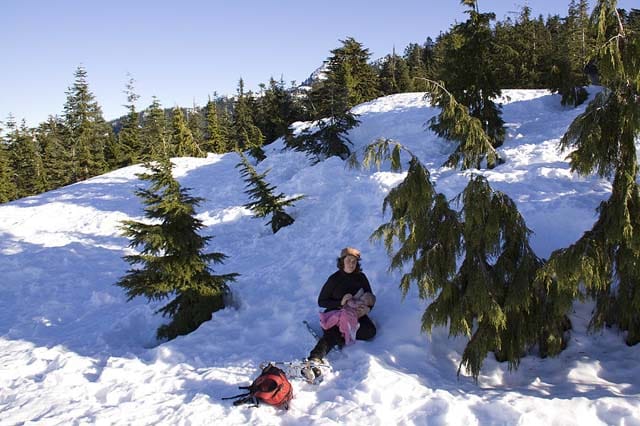
If you are still breastfeeding your baby, it means that you don’t have to worry about carrying formula on the hike… But you also have to figure out how to feed your baby without freezing your torso.
This is where a breastfeeding shirt really helps. Wear it as your base layer and at least your stomach won’t be completely exposed to the cold.
Another option is to wear a very low-neck for your core. Just unzip your shell and mid-layer so you can access your boobs from above. Then your core stays completely covered.
Do you have any winter hiking tips to add to this? How does your baby handle the cold? Let us know in the comments section below.
Image credits:
“Good place for a snack” (CC BY-NC 2.0) by Jenny Lee Silver
Lyra sitting in the snow” (CC BY-NC 2.0) by Jenny Lee Silver
“Arttu in Vaherma” (CC BY-NC-ND 2.0) by roxeteer
“Eat it of course” (CC BY-NC 2.0) by Scott SM


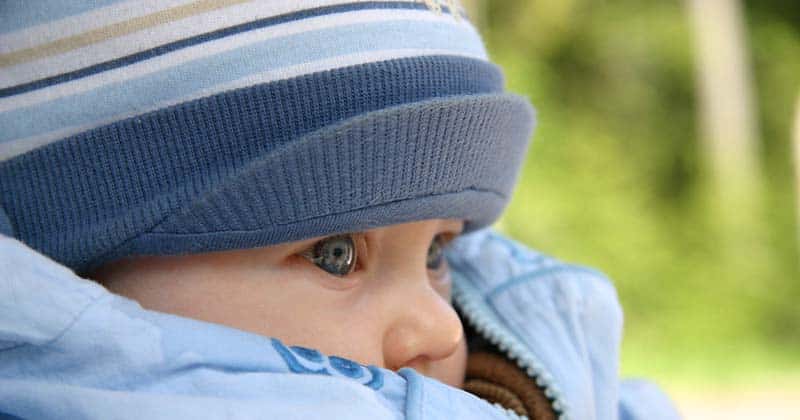
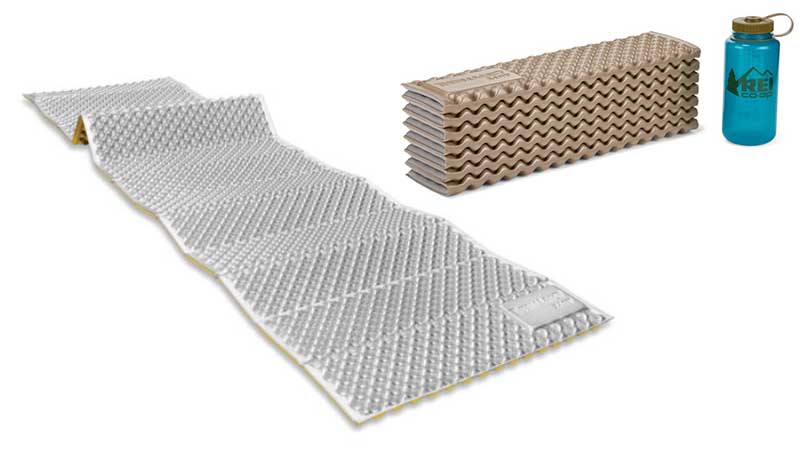
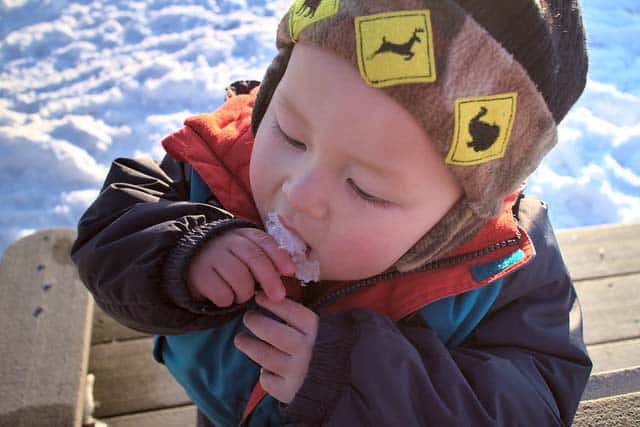
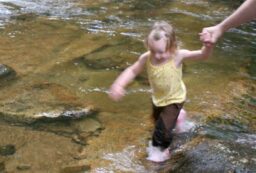
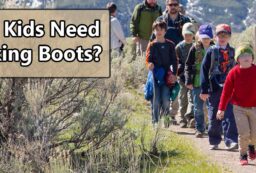
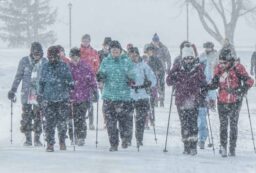







2 Comments
Megan Weise
December 12, 2021 at 5:18 pmThank you so much for this guide! I have an 8 month old who I have been hiking with for the last couple of months. I am excited to continue hiking this winter with her! Thanks for all these tips!
Marwan
November 11, 2022 at 3:39 pmThanks for all the tips. I am taking my 10 months old baby hiking this winter in NJ and I am bit stressed about it.
Thanks